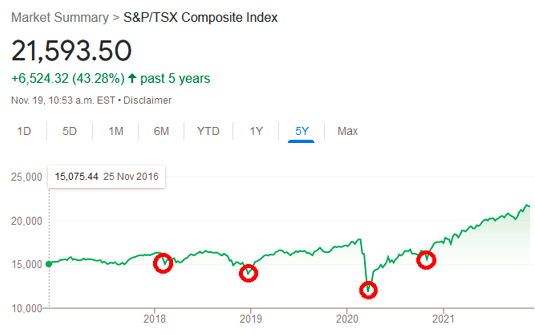You’ve retired! You’re finally at the stage in life where you’ve flipped “off” the savings switch and begun living off your hard-earned assets. Unfortunately, taking an income in retirement isn’t as easy as flipping a switch. There are many considerations to make, such as taxation, ordering of withdrawals, and investment strategy.
Today I’m going to dive deeper into the risks of a poor investment strategy for retirement assets and offer some tips do it better!
The Risks of “Bad Drawdowns”
What do I mean by a “bad drawdown”? Ultimately, it’s the act of selling investments at a low point in the market cycle (selling low and buying high is generally a very bad investing habit!). When you’re retired, you’re anticipating a smooth, consistent income from your investments. Every few weeks or each month, you would like funds deposited in your bank account. Stock and bond markets, however, don’t move in a straight predictable line.
Good investment practice would be to avoid selling when markets are down. But if your retirement accounts are set up to automatically sell on the same date each month, you could unknowingly be drawing on your assets on the worst day of the month or even the worst day of the year!
Example:
Let’s imagine a hypothetical year of returns on a $100,000 account that sells $1,000 each month:
| Month | Starting Value | Investment Return | Amount Redeemed | Ending Value |
| January | $100,000 | -4% | $1,000 | $95,000 |
| February | $95,000 | -3% | $1,000 | $91,150 |
| March | $91,150 | -6% | $1,000 | $84,681 |
| April | $84,681 | 4% | $1,000 | $87,068 |
| May | $87,068 | 2% | $1,000 | $87,810 |
| June | $87,810 | -1% | $1,000 | $85,932 |
| July | $85,932 | 2% | $1,000 | $86,650 |
| August | $86,650 | 3% | $1,000 | $88,250 |
| September | $88,250 | 5% | $1,000 | $91,662 |
| October | $91,662 | -3% | $1,000 | $87,912 |
| November | $87,912 | 2% | $1,000 | $88,671 |
| December | $88,671 | 0% | $1,000 | $87,671 |
Over the course of 12 months, $12,000 has been drawn out of the account but the account is down $12,329, making it a negative returning year. Had the account been left untouched, it would have been worth $100,331 at the end of the year, making it a positive returning year. The simple act of selling throughout the year, during the down months, caused a $660 swing in investment performance. In our hypothetical scenario, that’s nearly a full month of retirement income evaporated by “bad drawdown” timing, in only a single year!
What Can I Do About It?
The good news is there are actionable steps you can take to avoid the “bad drawdown” effect. You can ultimately do one of three things:
- You can take your income stream off of autopilot. If you manually review and observe your account holdings each month, you can elect to redeem only from the ones that make sense. You may find this tedious and a considerable amount of effort; however it is technically a method for avoiding poor timing.
- You can only hold safer, lower–returning investments. An easy way to get rid of the complications of volatility is to remove it from your investments entirely. The tradeoff is you should expect lower, long-term returns from less volatile investments. Which may simply be trading one problem for another.
- You can take your income stream from your safer holdings. I’ve written before about the advantages of drawing your income from the lower volatility portions of your portfolio. If you’re only drawing from low-risk holdings and systematically selling the high-risk holdings when they’re at a profit, you can immunize your retirement from “bad drawdowns!”
Planning for, monitoring and sustaining a retirement income is always going to mean putting in some work. Going into it with some “best practices” in mind and an awareness of the pitfalls is paramount to doing things right. With a little bit of fine-tuning, you can flip your retirement switch without a worry!

Recent Comments